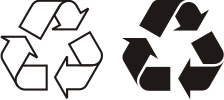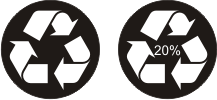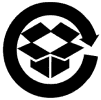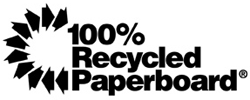Throughout the years, the recycling industry has invented variants of the symbol to distinguish each category of recycling (paper, plastic, glass, metal, etc..).
Attempting to prevent confusion between the various types of recycling, they have tried to standardize each kind. However, there are still many deviations of the recycling symbol, both regulated and not, which can make it even more complicated.
The American Paper Institute (API) promoted
four different variations of the same mobius loop to distinguish different recycling purposes. The solid black mobius loop or one with simply a white outline was used to identify material that was recyclable. The other two kinds, either black on white or white on black, had the mobius loop surrounded by a circle. They were used for material that was made of recycled paper, with the white-on-black version to be used for 100% recycled paper and the black-on-white for a mixture of recycled and non-recycled paper. The percentage of recycled paper that is used in the material is often written in the center. Recycled paper, as well as containing recycled paper, can be recycled as well, often reused in another product whose material requirements are less rigid.

Recyclable Paper

Recycled Paper
However, despite API’s efforts to regulate recycling, many variations of the same type of paper recycling still exist, which can be confusing and problematic.
In 1988, the American Society of the Plastics Industry also attempted to regulate their recycling system. They invented the resin identification code, a system which is used to indicate the most common component in a material. The symbols used in the code consist of the mobius strip triangle enclosing a number, and usually an acronym of the material used in the product. A symbol is placed on each plastic material, making it easier to identify
the type of plastic used, thus assisting recyclers in sorting. Below are symbols for the three most common plastics: Polyethene terephthalate, high-density polyethen, and polyvinyl chloride, respectively. PETE and HDPE account for 95% of plastic bottle resin usage.

Because of the costs of collecting, sorting, and cleaning, at the moment in most places in the US only two types of plastic (Polyethene terephthalate and high-density polyethene) can be recycled. Hopefully, in the future, the range of plastics that are recycled will become larger, which will vastly decrease the amount of plastic garbage and will benefit the environment.
Other materials have also developed a symbol for recycling as well, including glass, paperboard, and corrugated products. Corrugated products, made of paper that has an arched layer in the middle, are often used to make boxes because of their durability, and are often coated with wax. In this case, corrugated cannot be recycled, so it is important to identify which corrugated products are recyclable and which are not. For this reason, the Corrugated Packaging Council developed the corrugated recycles symbol.

Corrugated Recycles

Glass Recycles

100% Recycled Paperboard
Although most glass can be recycled, the Glass Packaging Institute (GPI) created a symbol for use on recyclable glass packaging to encourage the recycling of the product after consumption. And in recent years, the 100% Recycled Paperboard Alliance has developed a symbol of their own, signifying the material of the product has been made from 100% recycled matter. This symbol informs users that not only was the paperboard carton constructed with recycled material, but also reminds them that it still recyclable.
Although there are many variations of the mobius loop recycling symbol, it is extremely important that each kind can be distinguished and recognized. And, while it is the recycling industry’s responsibility to remind consumers, it still is your duty to take action and recycle.

















